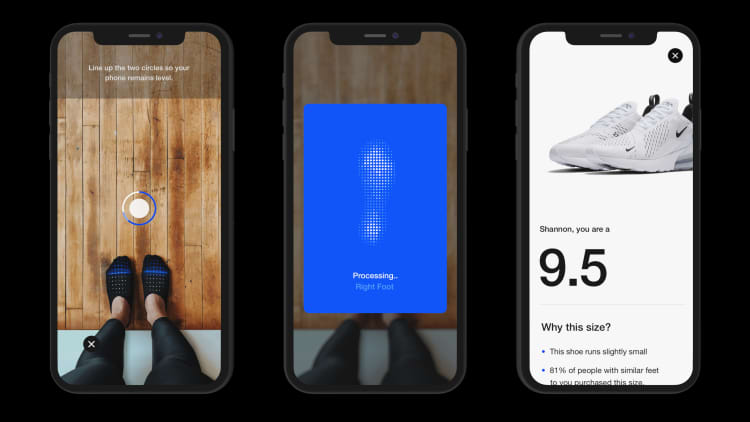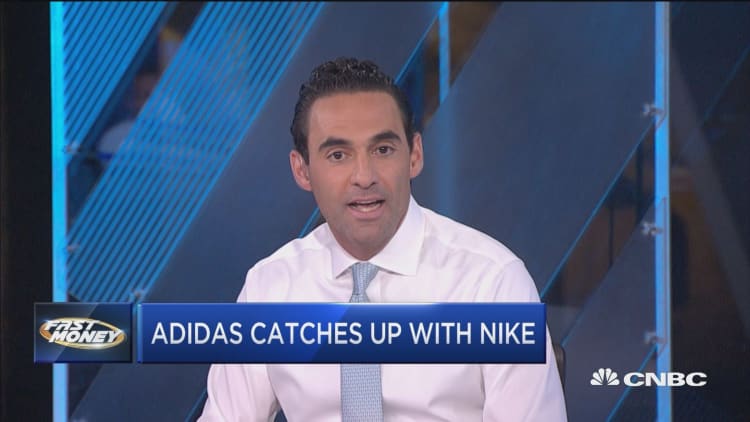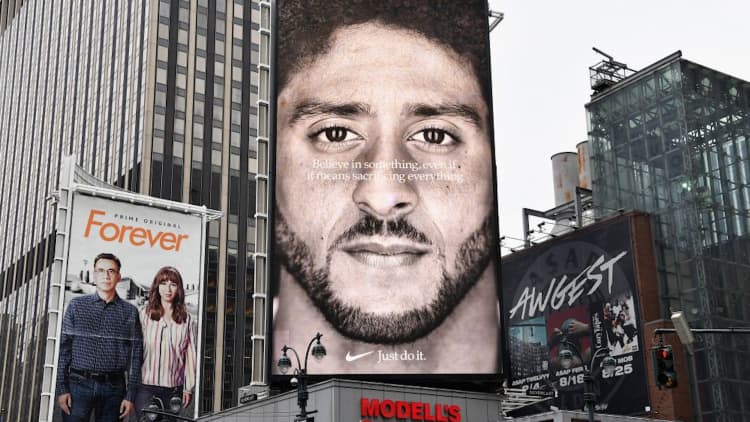
BEAVERTON, Ore. — Nike, the world's biggest sneaker maker, wants to solve a problem it knows far too many people have: Which size shoes will fit?
Many shoppers have gone online and ordered multiple pairs of the same style shoe, in different sizes, planning to send back what doesn't fit. The reasons are simple. Consumers often find they fit into different sizes — maybe a 7.5 women's here, an 8.5 women's there — depending on the brand and style. So, when it comes time to buy a new pair, there's a lot of guessing going on.
It's actually, very likely you don't even know what your true shoe size is. Your feet could also be two entirely different sizes.

"Fit is such a big friction point for our customers," said Michael Martin, Nike's global head of digital products. "We reached a point of realizing this was not just the biggest problem but biggest transformational opportunity that we have. ... No matter how good the shoe is, if the foot doesn't fit well within the shoe, you're not going to get peak performance from it."
Now, Nike says it has a solution. The company will launch Nike Fit, a service being added in North America this July to its mobile app and in stores. Nike Fit will scan customers' feet and determine the correct size. The service will roll out to Europe in August, moving to other international markets soon after.
Nike Fit is part of Nike's bigger push to sell more products directly to consumers through its own shops, website and mobile app, relying less on wholesale partners than it has in the past. And so Nike is opening new stores, like its House of Innovation in New York and Nike Live in Los Angeles, designed specifically for those markets and selling items visitors can't find anywhere else.
Nike said its direct sales in 2018 were up 12%, thanks to strong e-commerce growth and the opening of new stores. And it said direct-to-consumer revenue ended the year representing roughly 30% of total Nike brand sales, up from 28% in the prior year. With a market cap of roughly $130 billion, Nike has watched its shares climb nearly 22% over the past 12 months, outpacing the S&P 500 Retail ETF's (XRT's) decline of 1.5%.
Nike Fit will also help the retailer better manage inventory, cut down on returns and even entice shoppers to buy more shoes, early beta testing of the technology showed.
Down to the millimeter
At its core, Nike Fit will work when a customer opens the Nike app, selects a shoe to buy, and then instead of selecting a numerical size, the shopper will be presented with the option to scan his or her foot straight using a smartphone. A scan can take less than 15 seconds. And then Nike Fit will recommend a size for that particular shoe being considered. That information — such as the width of the shoppers' foot, down to the millimeter — will be saved for later purchases, too, because the size may vary with the style. Nike's Air Jordan shoe, for example, fits differently than other sneakers.
In stores, Nike will have a similar experience, but a sales associate will do the scanning.
It's staggering, data shows how many people are either squeezing into a shoe too small or have one falling off the foot.
At any given time, 3 in 5 people are wearing the wrong shoe size, based on industry research, Martin said. And the biggest reason for shoes being returned — whether they were purchased in store or online — is because of size, he said, adding that Nike receives more than 500,000 calls each year to its customer-service line related to sizing.
Return deliveries of all products will cost retailers $550 billion by 2020, according to estimates.
And, worse news for consumers, wearing the wrong size shoes can lead to injuries that can sideline them from playing a sport or from going to the gym. Foot injuries can also keep you from going to work. At least 60,000 foot injuries are responsible for keeping Americans out of the office each year, according to data from the Bureau of Labor Statistics.
Consumers more than ever want to have relationships with a brand. ... Those [retailers] that are winning are serving personally.Heidi O'Neillpresident of Nike Direct
In 2018, Nike spent an undisclosed amount to acquire Invertex, a computer-vision firm based in Israel to make Nike Fit possible. Years before this deal was finalized, Invertex had already begun working on a way to scan feet via a smartphone and make sizing recommendations, using machine learning.
Invertex CEO David Bleicher said many companies were approaching him and his colleagues by 2017 for their technology. But he said Invertex ultimately chose to work Nike, viewing the retailer as an "innovation powerhouse." Bleicher now heads a digital studio for Nike in Tel Aviv, where he says Invertex is working to solve "many other challenges" in the industry. "The bigger vision is to [help Nike] create better shoes," he said.

The rollout of Nike Fit isn't the first time Nike has tried to tackle the sizing issue.
In 2000, the company launched its Air Presto shoe — designed by Tobie Hatfield, brother of well-known Nike shoe designer Tinker Hatfield — in sizes like "small," "medium" and "large," mimicking how T-shirts are sized, not using numbers. But it was more of a test to see how shoppers reacted to the stretchy material in the Presto shoes and the T-shirt sizing. And Nike eventually went back to numerical sizing for the Presto about three years ago.
Barleycorn and Brannock devices
But numerical sizing can still be imprecise — and is incredible outdated.
The shoe sizing system is archaic, dating to the 1330s. It's somewhat of an urban legend that the reigning king of England in 1334 wanted a pair of shoes custom made for him. And when they didn't fit, he grew angry and decided to make some standard system of measurement, because there was none. The legend goes he declared three barleycorns, or grains of barley, were equal to an inch. And so 21 barleycorns became equivalent to a size 7 shoe, for example.
Fast forward to 1925, and the Brannock Device was made. That was an attempt by Charles Brannock to perfect the barleycorn method, adding a width measurement. You know, that (horribly uncomfortable) silver, metal tray that you slide your foot into, moving around little bars, to find your shoe size? That same Brannock is still found in Macy's shoe departments, Foot Lockers and DSWs across the country today.
"It was all well-intentioned, and it all had a good purpose," said Bill Tippit, a senior engineering director at Nike, about the Brannock. "We still use it today, but it really is the thing that just destroyed fit."
Then, there are a handful of up-start sneaker makers that have been looking for ways to solve this problem, too.
A Brooklyn-based company called Atoms, which sells its shoes to people only through invitations, has designed its sneakers in quarter sizes and will send customers three pairs at once. Then, a shopper can pick the two shoes that fit the left and right foot best, even if they're different quarter sizes.
Outside of shoes, bra-maker ThirdLove has embraced the idea of creating the perfect fit for women. It has a "fit finder" tool on its website for shoppers to answer questions and then receive personalized bra recommendations.
"The brands gaining favor with consumers today are ones who know how to relate," said Raj Nijjer, vice president of marketing at Yotpo. "They dialogue with customers, hear their pain points, and more often than not discover there's no such thing as one-size-fits-all. The brands that win are the ones that embrace their customers' individuality and deliver products with the perfect fit."
Shoring up the top spot
Beyond educating its customers on sizing, and hopefully helping more people avoid injuries from wearing the wrong size shoe, this technology could also be a financial boon for Nike, with its dominant position in the sneaker industry.
According to NPD Group sports analyst Matt Powell, Nike is the No. 1 footwear brand in the U.S. in terms of sales, representing roughly one-third of the market, ahead of Adidas, with 11% of the market, and Under Armour. It also remains really hot among teens with money to spend.
"Nike is not in any danger of giving up No. 1 by any means," Powell said. "The consumer today is looking for unique products," which Nike continues to churn out, he said.
However, Adidas, while it still holds a smaller share of the U.S. market, has been growing sales in the U.S. at a faster rate. In its latest reported quarter, Adidas said North America sales grew by more than 11%, compared with a 7% gain in Nike's sales in the region. Adidas is also ramping up for a sneaker collaboration with Beyonce, which is expected to generate momentum in the U.S.
In 2018, 64% of Nike brand revenues came from footwear — shoe sales were $22.27 billion out of $34.49 billion in total sales. That doesn't include sales from Converse, which operates as a separate business within Nike, and so Converse sneakers won't be compatible with Nike Fit.
Shoe sales were up 6% last year, excluding currency changes, thanks to strength in running, Nike said. But that was less than the 8% growth in footwear revenues in 2017, as Nike didn't sell as many Jordan shoes in 2018.
When testing Nike Fit in stealth in three markets — Seattle, Pasadena, California, and Dallas — Martin said the company noticed conversion rates increased for the people who used Nike Fit to find the right shoe size, meaning those people were more likely to leave the store with a bag in their hands. They were also more likely to come back later and buy another pair of shoes. Nike said returns were down at those stores. And associates spent less time running back and forth to the stock room to gather other sizes.
It can also help Nike stock the right inventory. Martin explained that Nike, like many shoe brands, typically ships shoes in bulk to different regions based on a standard "curve" that's long predicted for the industry how many people typically wear each shoe size. But he said that curve is not as exact as it could be. And so it's easy for companies to end up with too many size 10 sneakers in one market, when it's really the 9 that more of those people need to be wearing, for example. Data gathered from Nike Fit should help the company make its own curve of sorts.
"We've never had any data coming back to understand just how accurate is that distribution," Martin said.
Nike Fit is expected to help Nike grow its membership base, which amounts to more than 150 million people worldwide today. A Nike membership is free to sign up for and offers members early access to new products, a birthday reward, the ability to chat with athletes for tips on merchandise or training, and on-the-go workouts from Nike's app. The company says it's on track to increase its membership base to 300 million people, as those shoppers spend 40% more than guest customers, on average.
During its six-month trial run of Nike Fit in three stores, Nike said the service was the strongest lever to boost membership sign-ups that it has found.
"Consumers more than ever want to have relationships with a brand. They don't look at their experience with brands as transactional," said Heidi O'Neill, president of Nike Direct. "You see a more premium, more personal retail environment. Those [retailers] that are winning are serving personally."
Nike Fit is just the latest step in bringing a bigger vision to reality, according to Martin. He sees a day where shoe sizes don't exist. A customer goes to buy a pair of shoes, a box shows up with those shoes inside, and instead of a number on the outside it's your name — "Sarah" or "Michael."
But that will also require more of the industry to get on board with the idea that the Brannock Device is seriously outdated, and that consumers deserve better fit.
"We think this is a problem people have been trying to solve for a long time," O'Neill said. "But we feel super confident in our solution. ... We know we are going to have a new level of trust from consumers."



